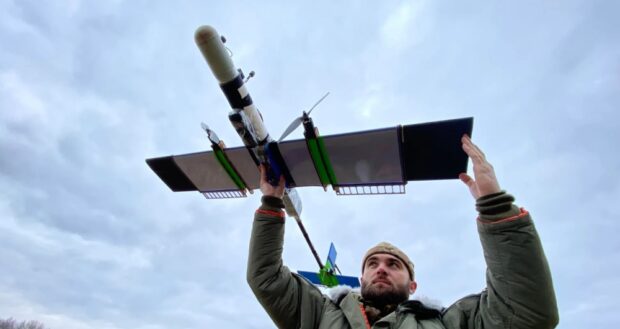Ukrainian inventors have developed the Khrushch strike system project which is a loitering munition that can be launched from another drone. The carrier drone is supposed to lift the loitering munition with a HEAT charge and, as it approaches the target, detach the munition that will go to the enemy.
The system consists of a control panel, a carrier drone, and the loitering ammunition itself. The type of charge that is attached to the “kamikaze drone” is selected depending on the target: 82mm high-explosive mortar round, PG-7VL HEAT charge, or TBG-7V thermobaric charge.
The Khrushch project was launched by inventors from the 67th Mechanized Brigade. The inventors’ team worked on developing the system.
The system is created in a way so that the loitering munition could perform combat missions on its own, without a carrier drone. Moreover, while similar UAV models are launched using special installations, the operator assistant can launch the Khrushch only by hand.
However, there is a significant difference between launching it manually or from the carrier. In the second case, the kamikaze drone does not need to spend a battery charge to reach altitude. In general, this system works to increase the distance of work. The main idea is not just to lift the drone but also to amplify the signal.
The fact is that at a certain distance from the target, video communication with the strike drone might disappear, for example, due to the geographical features of the location. It is crucial for the loitering munition operator to see the area to adjust the flight and point the UAV at the desired object if necessary. In this case, the carrier drone comes to the rescue.
This device is equipped with a repeater that can transmit a better signal. This gives the operator more time to aim and destroy the target. The developers were able to “pack” it with a variety of fuses and components that help the device to navigate in space, hold its flight trajectory, and remotely fire ammunition.
To produce the Khrushch, developers use foam, plywood, special films, and oilstones. The warhead connector is a PVC pipe. At the same time, each part of the device is made with special care and in accordance with the requirements of aerodynamics.
The team is already working to create the 6th prototype of the strike drone. Its design is modified to make the device lighter, more compact, and carry more useful weight, that is, a warhead.
As of now, the developers have two types of strike drones that operate at a distance of 10 and 20 kilometers. At 10 kilometers, the device carries a warhead weighing 1.5 kilograms, and at 20 kilometers – 2.7 kilograms.
23-minute video in Ukrainian
Advantages:
- Maximum load: 1500 g
- Protection against false alarms and trouble-free operation even in conditions of a powerful UPS;
- Wear-resistant micromotor with a metal gearbox (torque 2 kg/cm);
- Charging connector: Type-C (5V, 2A);
- Charging time: 15 minutes;
- More than 200 activations until full discharge;
- Standby mode for more than 30 days;
- Simple installation and rigid fixation of BC;
- Reliable and easy attachment to the drone, thanks to high-quality nylon Velcro.
The most difficult thing is to fix the target and direct the drone to a peak. Then, it’s just a matter of bringing the barrage munition to the object to be hit.
According to the developers, without taxation and logistics, the cost of a drone operating at 10 kilometers is $1,500, and at 20 kilometers – $2,000.
Full information on the Khrushch strike system project was published by Channel 24.
Top Photo: Khrushch loitering munition – Channel 24
Sources: Militarnyi Special Project;




